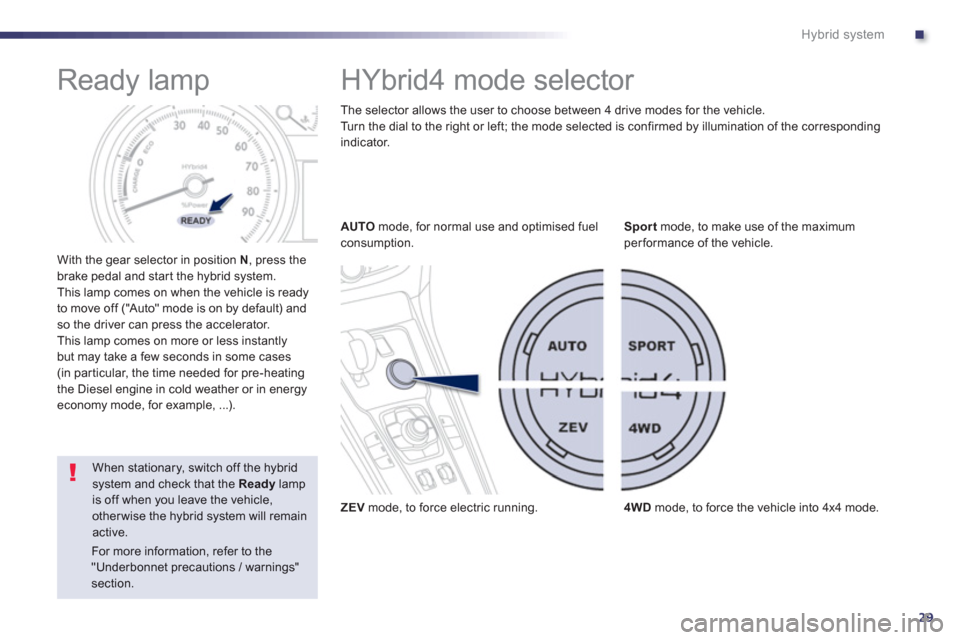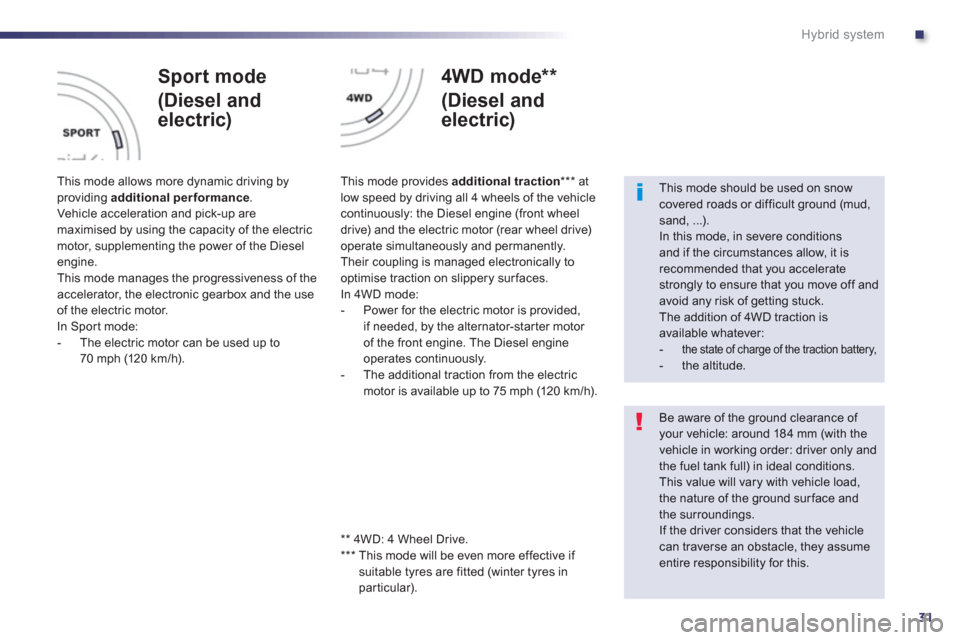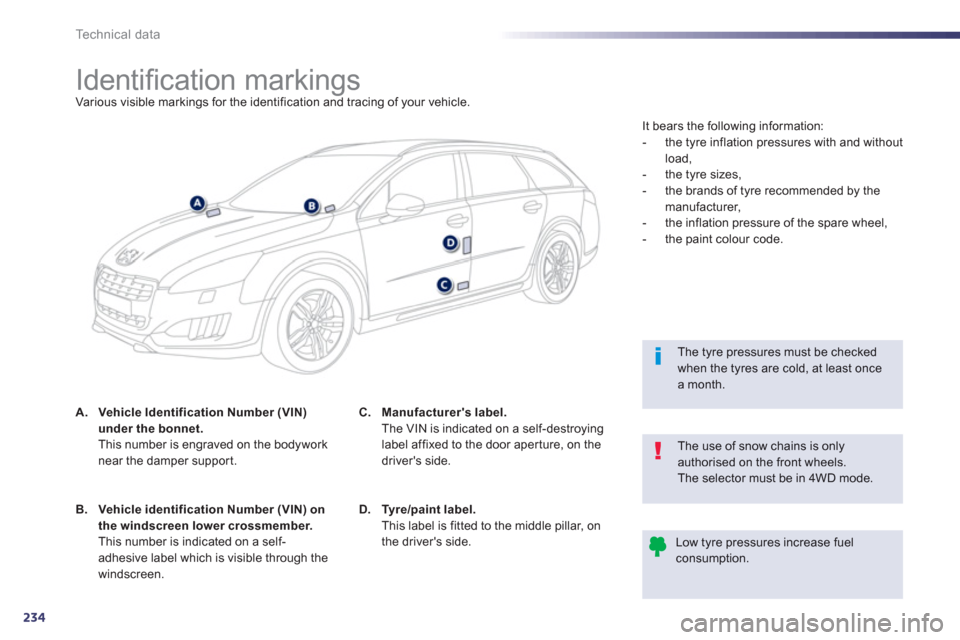4WD Peugeot 508 RXH 2013 Owner's Manual
[x] Cancel search | Manufacturer: PEUGEOT, Model Year: 2013, Model line: 508 RXH, Model: Peugeot 508 RXH 2013Pages: 308, PDF Size: 8.95 MB
Page 31 of 308

.
29
Hybrid system
Ready lamp
With the gear selector in position N, press the
brake pedal and star t the hybrid system.
This lamp comes on when the vehicle is read
y
to move off ("Auto" mode is on by default) andso the driver can press the accelerator.
This lamp comes on more or less instantlybut may take a few seconds in some cases (in par ticular, the time needed for pre-heating
the Diesel engine in cold weather or in energy economy mode, for example, ...).
HYbrid4 mode selector
AUTOmode, for normal use and optimised fuelconsumption.
ZEVmode, to force electric running.S
portmode, to make use of the maximum
performance of the vehicle.
4WDmode, to force the vehicle into 4x4 mode.
When stationary, switch off the hybridsystem and check that the Readylamp is off when you leave the vehicle,otherwise the hybrid system will remainactive. Th
e selector allows the user to choose between 4 drive modes for the vehicle.
Turn the dial to the right or left; the mode selected is confirmed by illumination of the corresponding indicator.
For more information, refer to the "Underbonnet precautions / warnings" section.
Page 33 of 308

.
31
Hybrid system
Sport mode
(Diesel and
electric)
This mode allows more dynamic driving byproviding additional performance. Vehicle acceleration and pick-up aremaximised by using the capacity of the electricmotor, supplementing the power of the Dieselengine.
This mode manages the progressiveness of the
accelerator, the electronic gearbox and the useof the electric motor.
In Spor t mode:
-
The electric motor can be used up to
70 mph (120 km/h).
4WD mode **
(Diesel and
electric)
This mode provides additional traction*** at low speed by driving all 4 wheels of the vehiclecontinuously: the Diesel engine (front wheel
drive) and the electric motor (rear wheel drive)
operate simultaneously and permanently.
Their couplin
g is managed electronically to
optimise traction on slippery surfaces.
In 4WD mode:
- Power for the electric motor is provided,
if needed, b
y the alternator-star ter motor
of the front engine. The Diesel engine
operates continuously.
- The additional traction from the electric
motor is available up to 75 mph (120 km/h).
This mode should be used on snow covered roads or difficult ground (mud,sand, ...).
In this mode, in severe conditions and if the circumstances allow, it is recommended that you accelerate strongly to ensure that you move off and avoid any risk of getting stuck.
The addition of 4WD traction isavailable whatever:
- the state of charge of the traction battery,
- the altitude.
Be aware of the ground clearance of your vehicle: around 184 mm (with the vehicle in working order: driver only and the fuel tank full) in ideal conditions.
This value will vary with vehicle load,the nature of the ground surface and the surroundings.
If the driver considers that the vehicle
can traverse an obstacle, they assumeentire responsibility for this.
**
4WD: 4 Wheel Drive.
***
This mode will be even more effective if suitable tyres are fitted (winter tyres in
particular
).
Page 35 of 308

.
33
Hybrid system
View hybrid fl ow information
Hybrid modes
1.
Hybrid mode selected (AUTO, ZEV, SPORT, 4WD). 2.Messages, e.g.: "Zero Emission" if the Diesel engine is off (0 g/km CO2).
Vehicle infrastructure
3.Diesel engine.4.
Tr a c t i o n b a t t e ry state of charge.
5. Electric Motor/Generator.
Operation / Energy flows
6.
The Diesel engine supplies the battery (if needed).
7.Arrow from left to right: the battery powers the electric motor (when
the electric motor is operating).
Arrow from right to left: the electric motor/generator recharges the
battery (energy recovery phases).8. The Diesel engine drives the front wheels. 9.The electric motor drives the rear wheels. Information on the active h
ybrid mode, arrows for energy flows and the state of charge of the battery, is displayed in the instrument panel screen or the screen.
Page 236 of 308

234
Technical data
Identifi cation markings Various visible markings for the identification and tracing of your vehicle.
A.Vehicle Identification Number (VIN) under the bonnet.
This number is engraved on the bodyworknear the damper suppor t.
The tyre pressures must be checked when the tyres are cold, at least oncea month.
Low tyre pressures increase fuelconsumption.
B.Vehicle identification Number (VIN) on
the windscreen lower crossmember.This number is indicated on a self-adhesive label which is visible through the
windscreen.
C.Manufacturer's label. The VIN is indicated on a self-destroying
label affixed to the door aper ture, on the driver's side.
D.Tyre/paint label. This label is fitted to the middle pillar, on
the driver's side. It bears the
following information:
- the tyre inflation pressures with and without
load,
- the tyre sizes,
- the brands o
f tyre recommended by the manufacturer,
- the inflation pressure of the spare wheel,
- the paint colour code.
The use of snow chains is onlyauthorised on the front wheels.
The selector must be in 4WD mode.